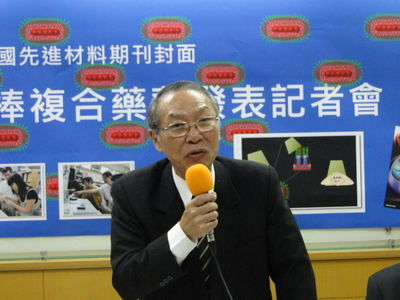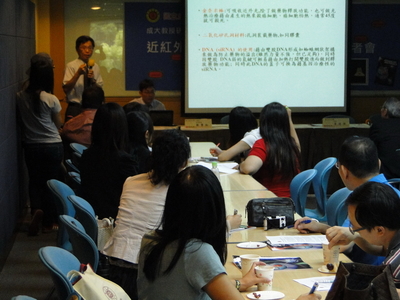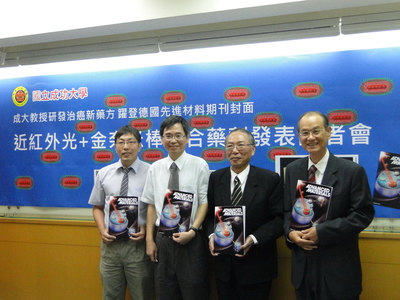NCKU team discovers new complex in treating cancer





Tainan, Taiwan, 22 August 2012
A National Cheng Kung University (NCKU) research team has discovered Near-Infrared Light-Responsive oligonucleotide-gated Au nanoensembles (Au nanorod complex), a potent new anti-cancer complex that is seen as a promising targeted therapy for curing cancer.
This medical discovery was selected as an important and urgent paper, becoming the image of back cover in the July 2012 issue of Advanced Materials, and has drawn big attention in the academic world and the biotechnology industry as well.
The team, led by Chen-Sheng Yeh, NCKU distinguished professor of Department of Chemistry, focused on the development of NIR light-responsive oligonucleotide-gated Au nanoensembles (Au nanorod complex) for cancer therapy and the result proved that Au nanorod complex could provide better efficiency of cancer therapy by reducing the cancer survival rates by 30%.
Au nanorod complex provides a new platform for cancer therapy, a platform which, depending on different diseases, encapsulates different drugs and small interfering RNA (siRNA) which has special functions to achieve chemotherapy and gene therapy, according to Professor Yeh.
Professor Yeh pointed out that the surface of Au nanorod complex coated with silica can encapsulate anti-cancer drugs.
To avoid the loss of anti-cancer drugs from Au nanorod complex during the delivery process and reduce side effects of anti-cancer drugs, the double-stranded DNA (dsDNA) as a net in covering the surface pores was used to conjugate on the surface pores of silica.
When Au nanorod complex was irradiated with NIR light, Au nanorods absorbed NIR light and were transferred to heat.
The generated heat transferred from Au nanorods to outside dsDNA induced dehybridization of the dsDNA as the net was destroyed by heat. After dehybridization of dsDNA, the encapsulated drugs were released from mesopores to outside and killed cancer cells.
Experimental results show that cancer survival rate can be reduced from 80% to about 50%, confirming the gold nanorods pharmaceutical compound has achieved good therapeutic effect.
The advantage of using NIR light to trigger drug release was that NIR was the biological window, where both blood and soft tissues transmission is optimal due to low energy absorption, providing maximum penetration. Therefore, the developed Au nanorod complex has triggered drug release, maximizing the therapeutic properties of both chemotherapy and gene therapy.
Moreover, the design of the treatment which can be tailored by the medical needs to load the appropriate drug treatment is believed to be a very curative treatment platform, according to Yeh.
Yeh’s team has applied for patent in Taiwan and the United States, and will continue to conduct animal testing and human trials.
A National Cheng Kung University (NCKU) research team has discovered Near-Infrared Light-Responsive oligonucleotide-gated Au nanoensembles (Au nanorod complex), a potent new anti-cancer complex that is seen as a promising targeted therapy for curing cancer.
This medical discovery was selected as an important and urgent paper, becoming the image of back cover in the July 2012 issue of Advanced Materials, and has drawn big attention in the academic world and the biotechnology industry as well.
The team, led by Chen-Sheng Yeh, NCKU distinguished professor of Department of Chemistry, focused on the development of NIR light-responsive oligonucleotide-gated Au nanoensembles (Au nanorod complex) for cancer therapy and the result proved that Au nanorod complex could provide better efficiency of cancer therapy by reducing the cancer survival rates by 30%.
Au nanorod complex provides a new platform for cancer therapy, a platform which, depending on different diseases, encapsulates different drugs and small interfering RNA (siRNA) which has special functions to achieve chemotherapy and gene therapy, according to Professor Yeh.
Professor Yeh pointed out that the surface of Au nanorod complex coated with silica can encapsulate anti-cancer drugs.
To avoid the loss of anti-cancer drugs from Au nanorod complex during the delivery process and reduce side effects of anti-cancer drugs, the double-stranded DNA (dsDNA) as a net in covering the surface pores was used to conjugate on the surface pores of silica.
When Au nanorod complex was irradiated with NIR light, Au nanorods absorbed NIR light and were transferred to heat.
The generated heat transferred from Au nanorods to outside dsDNA induced dehybridization of the dsDNA as the net was destroyed by heat. After dehybridization of dsDNA, the encapsulated drugs were released from mesopores to outside and killed cancer cells.
Experimental results show that cancer survival rate can be reduced from 80% to about 50%, confirming the gold nanorods pharmaceutical compound has achieved good therapeutic effect.
The advantage of using NIR light to trigger drug release was that NIR was the biological window, where both blood and soft tissues transmission is optimal due to low energy absorption, providing maximum penetration. Therefore, the developed Au nanorod complex has triggered drug release, maximizing the therapeutic properties of both chemotherapy and gene therapy.
Moreover, the design of the treatment which can be tailored by the medical needs to load the appropriate drug treatment is believed to be a very curative treatment platform, according to Yeh.
Yeh’s team has applied for patent in Taiwan and the United States, and will continue to conduct animal testing and human trials.
Provider:
新聞中心
Date:
101.08.22



